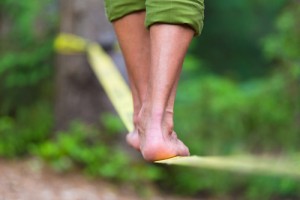Researchers Study Device to Improve Balance for MS Patients

 Multiple sclerosis (MS) patients often experience difficulty with balance and fear falling, which may prevent them from being social or participating in exercise and community activities, affecting their quality of life. However, a pioneering study conducted at the University of Massachusetts Amherst is looking to understand the role of foot sensations in balance and if vibrating insoles may be able to improve balance capacity for those with MS.
Multiple sclerosis (MS) patients often experience difficulty with balance and fear falling, which may prevent them from being social or participating in exercise and community activities, affecting their quality of life. However, a pioneering study conducted at the University of Massachusetts Amherst is looking to understand the role of foot sensations in balance and if vibrating insoles may be able to improve balance capacity for those with MS.
The negative effects of lack of balance is a problem not only in itself, but can also cause patient fatigue and anxiety when walking. Therefore, the research team is investigating foot sensations in MS patients while they are standing in order to assess if balance could be improved with vibrating insoles. The research is being supported by a one-year, $39,000 grant awarded by the National Multiple Sclerosis Society.
Assistant professor Stephanie Jones and professor Richard van Emmerik, both from the department of kinesiology at UMass Amherst, are responsible for the study and will test sensations in two different regions in the soles of the foot in both healthy participants and those suffering from MS. The examination will be conducted as the subjects stand and as they sit, and the investigators will analyze the data to look for evidence that relates to balance ability.
The study will be the first of its kind to analyze subjects both sitting and standing, as explained by the researchers, who will try to determine if thresholds differ with weight bearing in patients with MS. This kind of research is usually conducted with participants lying down. The study will include 30 people, between 21 and 65 years old who are ambulatory and able to stand unassisted.
The research will use a 25-foot walk function test, muscle strength testing, tests of pressure and vibration sensation of the skin, standing balance and posture evaluation in order to establish baselines. “There is a lot of evidence that the somatosensory system, that is the skin’s sensation and body awareness or proprioception, is affected in people with MS, who often report peripheral sensory loss, for example,” said Jones.
[adrotate group=”4″]
Vibration will be applied to the soles of the participants’ feet at a level below the detection threshold, as the researchers are basing their work on recent technology that they believe is able to improve skin sensation. Receiving small, irregular vibrations have been demonstrated efficient in restoring part of sensation previously lost, as well as in improving balance, as shown by previous studies conducted on people who have lost sensation in the feet due to diabetes or strokes.
“This method exploits the phenomenon of stochastic resonance of the nervous system. It applies a kind of ‘noise’ that can enhance a person’s skin sensation,” Jones added. In order to apply the vibration, the researchers will use small devices called “tactors,” which will be inserted inside the participants’ shoes. With the tactors placed, the subjects will be submitted to blind tests, without knowing if the device is active or not.
“Because their nervous system is compromised, people with MS show a much greater delay in detecting and responding to unexpected balance disturbances,” explained Jones. “One of our goals is to see if we can enhance the ability to detect and respond to a sudden challenge and in doing so, improve balance. In this case, the challenge will be a shift of the surface underfoot, a bit like what you get when you step onto an escalator.”
During the last stage of research, the team will analyze if the factors are able to help MS patients respond to sudden balance problems, and to determine this, the participants will be asked to stand on a 3-inch platform that will move unexpectedly. “This is not enough to cause most people to fall but it’s enough to see the muscles fire that are needed to keep you upright,” Jones said.
“We hope tactors might reduce that delay so that these muscles will fire sooner and the person would be less de-stabilized with them in place. If we identify this mechanism of somatosensory impairment in MS, perhaps we can develop other interventions to try to do more,” the investigator added.






